Abstract
The design of a vane-type magnetron with a resonant frequency in the megahertz range is presented in this article. The initial dimensions are determined based on magnetron empirical formulas. CST Studio Suite was used to simulate a series of magnetron behaviors, including eigenmode analysis and particle-in-cell (PIC) simulations. The relationship between volume and frequency results in a significantly large magnetron size for MHz frequencies. Considering manufacturing convenience and cost factors, the magnetron was simplified from its initial design, and the operating frequencies were compared, revealing a difference of about 40 MHz. The simulated frequency was 193 MHz, and the magnetron field patterns were simulated using CST. In the simulation, a horn antenna-like structure was employed to reduce the magnetron’s half-power beamwidth (HPBW), narrowing it from 101 to 50°. The result of this study can be used for beam focusing.
1. Introduction
Due to recent breakthroughs in microwave technology, their reduced cost, and improved performance, magnetrons are widely used in household, commercial, and industrial applications. There are various types of magnetrons which are easy to manufacture and have stable outputs, such as the vane type, the hole-and-slot type, and the rising-sun type. The various components of a magnetron have complex interrelationships, and the development of simulation software (CST/MAGIC) has enabled the visualization and understanding of the interactions between beam waves []. Much discussion has also been conducted regarding traditional magnetron PIC simulations [,].
We conducted cold and hot simulations using the eight-vane-type resonant system (the anode block) and a hollow cathode (Figure 1). Initial dimensions were determined along with the cold and hot simulation settings. The field of the designed magnetron was explored, and improvements were proposed in this study.
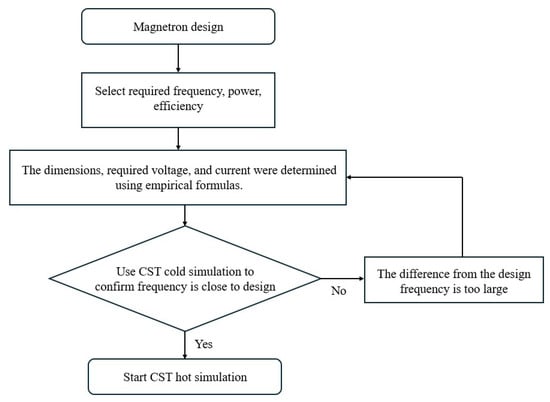
Figure 1.
Simulation process in this study.
2. Magnetron Design
Magnetron Design Process
Firstly, the frequency, power, and efficiency were determined. Next, the impedance was determined based on the selected power. The voltage and current were derived from the impedance and power. The dimensions were obtained by applying (1)–(8) [,]. In the equations, B, V, I, ra, rc, h, and N present the magnetic flux density, anode voltage, anode inner radius, cathode radius, anode height, and the number of resonators. b, σ, v, i, and A denote constants, and a parameter was derived using the B/B0 relationship diagram []. The selected voltage and magnetic field were compared with the curve of Buneman–Hartree vs. the Hull cut-off voltage to produce a stable mode []. The end caps above and below the cathode effectively ensure that electrons do not escape and that the efficiency is improved [,]. The height of the output antenna does not affect the resonant frequency, but it slightly impacts the efficiency [].
The circuit efficiency ηc was set at 85% (the typical range is 80–90%), the power was 1 kW, the total efficiency ηc was 75%, and the impedance was 11.5 kΩ, according to the total efficiency ηt []. The geometric structure used in magnetron simulation is presented in Figure 2. Table 1 shows the detailed parameters of the 193 MHz magnetron.
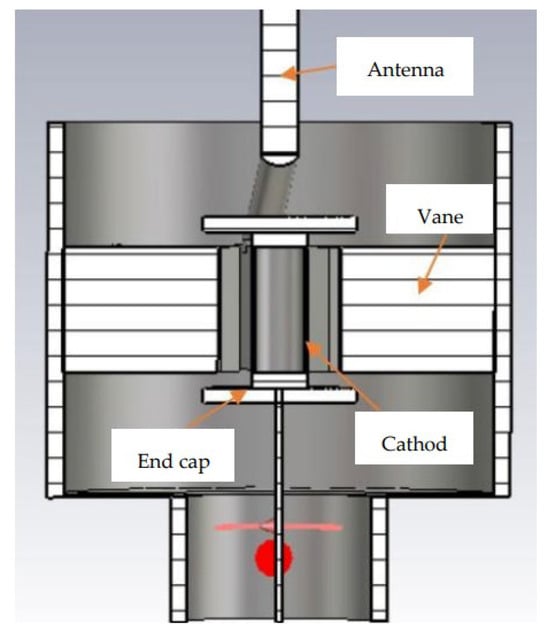
Figure 2.
Magnetron cross-section.

Table 1.
Parameters of 193 MHz magnetron.
3. Simulations
In this study, CST Studio SuiteTM (CST Studio Suite 2023) simulation software was used for modeling and hot and cold simulation. Eigenmode analysis, also known as cold simulation, is used in a simulation without a voltage or magnetic field, and particle-in-cell (PIC) simulation, also known as hot simulation, is conducted with a feed voltage and magnetic field. The time domain solver in CST was used in the radiation pattern simulation of the magnetron.
3.1. Cold Simulation
The designed magnetron was eigen-simulated. The PIC simulation took a long time, and the results were unsatisfactory. However, in the eigenmode simulation, the magnetron was used for about 5 min. The resonant frequency of the tube was controlled, and a voltage and a magnetic field were applied in the PIC simulation to measure the output power, voltage, and resonant frequency. In the eigenmode simulation, the boundary condition was set to Et = 0, and a tetrahedral mesh was used to improve accuracy. Figure 3 shows the results of the eigensimulation.
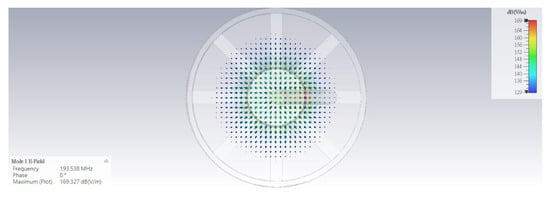
Figure 3.
The eigenmode simulation result shows that the resonant frequency is 193.538 MHz.
3.2. Hot Simulation
To determine the output power and voltage, a complex PIC simulation was required. The input voltage of 30 kV was applied to the cathode input column, and the magnetic field along the Z-direction was 0.18 T. The total simulation time was 500 ns, and the grid count was 154,440. Particle emission mode requires a microwave oven magnetron with explosive emission. The rise time was 1 ns, particle kinetic energy was 3 keV, and 2974 particles were emitted. The CPU was accelerated in the PIC simulation to reduce the simulation time. Accelerated simulation with six CPUs took about three hours. In Figure 4, discrete voltage levels were fed into the system, and a waveguide port was set at the output to capture the output signal. A Fourier transform was then performed to convert the signal into a spectrum diagram. In Figure 5, the signal rise time for the fed voltage is 1 ns, and the total time is 500 ns. With the above parameters, the frequency and output power values under the influence of the voltage and magnetic field are determined. Figure 6 shows the output frequency results after Fourier transformation. Figure 7 shows the measured output power at 193 MHz, with an initial power of approximately 1.2 kW and a steady-state power of approximately 400 W.
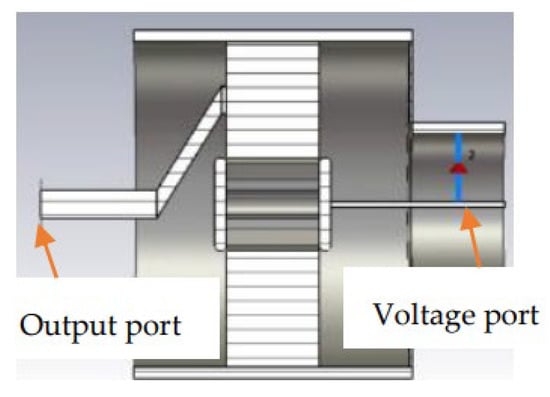
Figure 4.
Voltage feed position and output pickup point.

Figure 5.
Total duration of 500 ns and rise time of 1 ns.
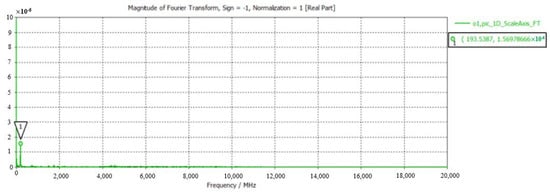
Figure 6.
Measured value (193.538 MHz) of Fourier transform output port.
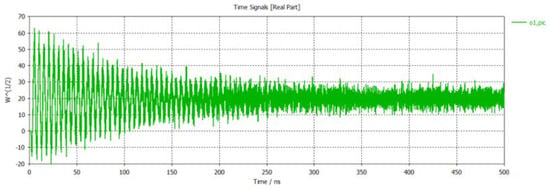
Figure 7.
Power measured at 193 MHz output port.
4. Radiation Pattern Simulation
The field diagram simulation results provide an understanding of the radiation state, such as directivity and half-power beam width (HPBW), making the subsequent experiments efficient. The software used for this magnetic field simulation is CST, and the boundary conditions are set to “open”. The connection port is located at the bottom of the antenna, as shown in Figure 8.
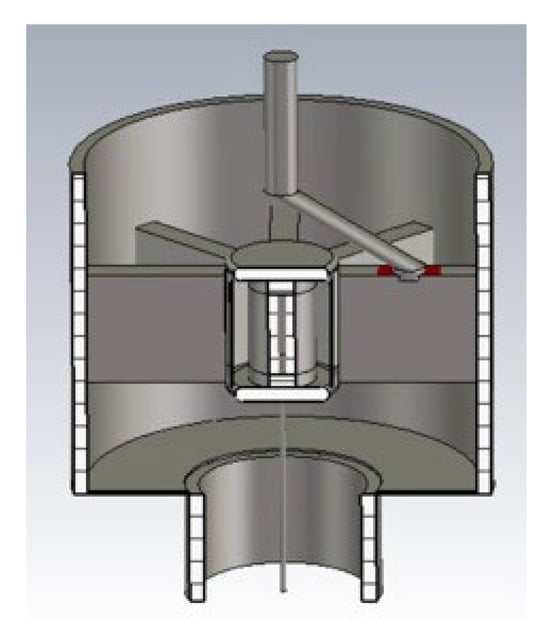
Figure 8.
Input port location.
The beam concentration of the single magnetron simulation is not ideal. To address this, a three-layer shell structure is adopted. Each layer is taller than the previous one, ultimately forming a horn-antenna-like shape. Figure 9 shows the field pattern of the standalone magnetron. Figure 10 shows a cross-sectional view of the magnetron added to the outer box. Figure 11 shows the magnetron field pattern after the enclosure is added. Table 2 summarizes the radiation parameters of the magnetron without the casing and with the casing added.
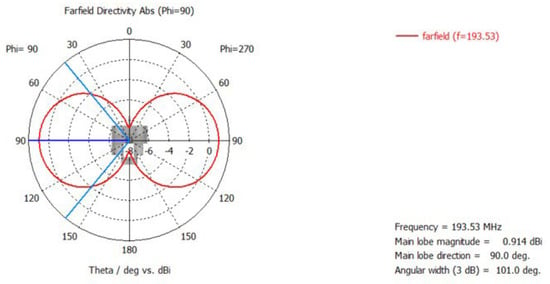
Figure 9.
Single magnetron field pattern with directivity of 0.941 and HPBW of 101°.

Figure 10.
Cross-sectional view of magnetron added to outer box.
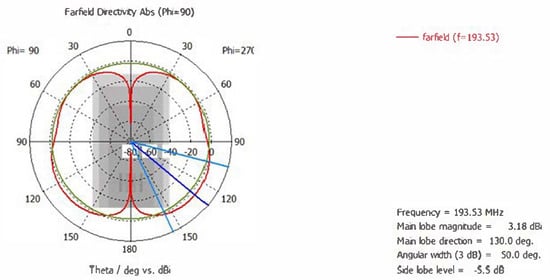
Figure 11.
Magnetron field pattern after adding outer box.

Table 2.
Radiation parameters of magnetron.
5. Conclusions
We designed a magnetron with a resonant frequency of 193 MHz and a power output of 400 W using empirical formulas, CST eigenmode simulation, and PIC simulation. We simulated a magnetron field pattern and reduced the original HPBW of 90° from the standalone magnetron to 50° using a horn antenna-like enclosure. This is a promising result for future wireless power transmission applications.
Author Contributions
Conceptualization, C.-H.S.; methodology, C.-H.S. and M.-X.K.; software, M.-X.K.; validation, C.-H.S. and M.-X.K.; formal analysis, C.-H.S. and M.-X.K.; investigation, C.-H.S.; resources, C.-H.S.; data curation, C.-H.S. and M.-X.K.; writing—original draft preparation, C.-H.S. and M.-X.K.; writing—review and editing, C.-H.S.; visualization, C.-H.S. and M.-X.K.; supervision, C.-H.S.; project administration, C.-H.S.; funding acquisition, C.-H.S. and M.-X.K. All authors have read and agreed to the published version of the manuscript.
Funding
This research received no external funding.
Institutional Review Board Statement
Not applicable.
Informed Consent Statement
Not applicable.
Data Availability Statement
The data presented in this study are available upon request from the corresponding author.
Conflicts of Interest
The authors declare no conflict of interest.
References
- Khatoon, S.; Yadav, R.P.; Jain, A. Design and Simulation of 8-cavity hole-slot type magnetron in CST. In Proceedings of the 2nd International Conference on Electronics, Materials Engineering & Nano-Technology (IEMENTech), Kolkata, India, 4–5 May 2018; pp. 1–5. [Google Scholar]
- Kim, J.-I.; Won, J.-H.; Ha, H.-J.; Shon, J.-C.; Park, G.-S. Three-Dimensional Particle-in-Cell Simulation of 10-Vane Strapped Magnetron Oscillator. IEEE Trans. Plasma Sci. 2004, 32, 2099–2104. [Google Scholar] [CrossRef]
- Kim, D.-H.; Jung, S.-S.; Kim, J.-I.; Jeon, S.-G. Three-Dimensional Particle-in-Cell Simulation on a Magnetron Oscillator with Mismatched Loads. J. Korean Phys. Soc. 2009, 54, 1675–1679. [Google Scholar] [CrossRef]
- Collins, G.B. Microwave Magnetrons (MIT Radiation Laboratory Series); McGraw-Hill: New York, NY, USA, 1948. [Google Scholar]
- Vyas, S.K.; Maurya, S.; Verma, R.K.; Singh, V.P. Synthesis and simulation studies of a 10-kW 2.45-GHz CW magnetron. IEEE Trans. Plasma Sci. 2015, 43, 3615–3619. [Google Scholar] [CrossRef]
- Vyas, S.K. Synthesis and analysis of strap & vane resonator of an efficient 10 kW CW Magnetron—A Design Approach. In The Technical Writer’s Handbook; Young, M., Ed.; University Science: Mill Valley, CA, USA, 1989. [Google Scholar]
- Vyas, S.K.; Maurya, S.; Singh, V.P. Electromagnetic and Particle-in-Cell Simulation Studies of a High Power Strap and Vane CW Magnetron. IEEE Trans. Plasma Sci. 2014, 42, 3373–3379. [Google Scholar] [CrossRef]
Disclaimer/Publisher’s Note: The statements, opinions and data contained in all publications are solely those of the individual author(s) and contributor(s) and not of MDPI and/or the editor(s). MDPI and/or the editor(s) disclaim responsibility for any injury to people or property resulting from any ideas, methods, instructions or products referred to in the content. |
© 2025 by the authors. Licensee MDPI, Basel, Switzerland. This article is an open access article distributed under the terms and conditions of the Creative Commons Attribution (CC BY) license (https://creativecommons.org/licenses/by/4.0/).